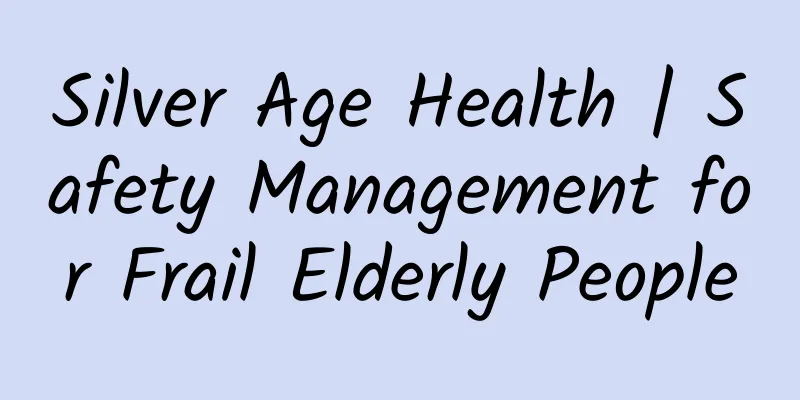Silver Age Health | Safety Management for Frail Elderly People

|
Safety management of frail elderly patients: With the aging of the population, the number of elderly patients increases year by year, and the number of frail elderly patients is also increasing. As the elderly age, their physical functions gradually decline, their immunity decreases, and they are more susceptible to infection and disease. Therefore, the safety management of elderly patients has received more and more attention. This article will explain the physiological characteristics of frail elderly patients, the improvement of safety awareness, and the implementation of safety protection measures. Elderly patients are at increased risk for safety events. Multiple studies have evaluated the impact of age on the incidence of safety events in the elderly and have reached the same conclusion that older adults are more likely to experience adverse events compared to younger adults. As they age, they are more likely to have chronic conditions, which can lead to higher utilization of the healthcare system, including hospital stays and longer recovery times. The coexistence of multiple chronic conditions further increases this risk while raising the possibility of more complications related to polypharmacy. In addition, the natural progression of normal aging, including decreased bone density, decreased muscle strength, and increased skin fragility, makes older adults more vulnerable to treatment- and drug-induced side effects, such as infections or delirium. ▏Definition and characteristics of frail elderly people Frail elderly people generally refer to those aged 65 and above who are in poor physical condition, have difficulty in moving, and are prone to injury or illness. Their characteristics are: 1. Decreased physiological function As people age, their physiological functions gradually decline, including cardiopulmonary function, metabolic function, immune function, etc. This makes elderly patients more susceptible to various diseases, such as cardiovascular disease, lung infection, diabetes, etc. 2. Osteoporosis The bones of the elderly are prone to osteoporosis, which makes elderly patients prone to fractures. 3. Decreased perception The elderly have reduced sensory abilities, including vision, hearing, and touch, which makes it difficult for elderly patients to detect danger and take timely risk avoidance measures. 4. Memory loss Elderly people suffer from memory loss and are prone to forgetting to take medicine, forget to eat, etc. This may lead to the deterioration of the health status of elderly patients. 5. Mobility difficulties The physical function of the elderly declines, their mobility is inconvenient, and they are prone to falls and collisions, etc. This increases the risk of accidental injuries in elderly patients. ▏Things to note when treating frail elderly people 1. Multiple diseases About 70% of the elderly have two or more chronic diseases. 2. Weakness Weakness is due to the disorder of multiple physiological systems, loss of physiological reserves and defense capabilities, which makes it more likely to lead to various diseases and poor prognoses. Clinically, it manifests as weakness, slow movements, reduced physical activity, weight loss, inability to take care of oneself, and easy falls. 3. Polypharmacy (taking four or more medications) Taking too many medicines will increase the interactions between drugs and cause adverse reactions. It will also increase drug expenses and reduce compliance, causing patients to suffer greater psychological pressure. 4. Cognitive impairment The elderly may suffer from severe learning or memory disorders due to the degeneration of brain function, accompanied by aphasia, dementia, and even delusions and hallucinations. At this time, their personal self-care management and treatment compliance will be greatly reduced. At the same time, communication and transitional care during the nursing process, as well as the transfer of patients, are also huge challenges. 5. Functional status Elderly people of the same age may have different functional states, which can directly affect the management of the disease, compliance with treatment, the ability to return to the hospital for follow-up visits, and the risk of complications. The elderly's condition itself may also affect his personal state. For example, if a patient has angina pectoris, he may be unable to take care of himself for a long time, maintain an independent life and maintain his quality of life. 6. Setting treatment and nursing goals When receiving treatment, the elderly may not care much about their longevity, but rather the quality of life. The wishes of patients should be respected, so doctors should discuss decisions with patients in communication and let them have the absolute right to make decisions. The concepts of "shared decision-making" and "patient-centered" between doctors and patients are more important for older patients. The treatment provided by doctors must meet the needs of patients, who prefer their quality of life and best interests, so the participation of patients in clinical decision-making is an important concept reflected in my relative's case. ▏Measures and methods for safety management of frail elderly people 1. Establish a home security system Home safety system is one of the important measures to ensure the safety of the elderly. The home safety system includes installing monitoring equipment, installing access control systems, setting up smoke alarms, etc. These devices can help children and medical staff to detect accidents and diseases of the elderly in time and take timely measures to rescue them. 2. Develop a reasonable exercise plan A reasonable exercise plan can help frail elderly people strengthen their physique, improve their immunity, and prevent diseases such as fractures. Elderly people can choose a suitable exercise method according to their physical condition and hobbies, such as walking, Tai Chi, yoga, etc. Pay attention to safety when exercising to avoid overwork and injury. 3. Keep the indoor environment clean and hygienic Keeping the indoor environment clean and hygienic can reduce the risk of infection for the elderly. The elderly should clean regularly, remove garbage and waste, and maintain good ventilation and lighting. In addition, the elderly should also pay attention to personal hygiene, wash hands frequently, take a bath frequently, and change clothes frequently. 4. Arrange your diet properly A reasonable diet can help frail elderly people strengthen their physique and prevent the occurrence of diseases. The elderly should pay attention to food hygiene and avoid eating expired and spoiled food. In addition, the elderly should also pay attention to a balanced diet and take in enough nutrients, such as protein, fat, carbohydrates, vitamins and minerals. 5. Enhance self-protection ability Enhancing the self-protection ability of the elderly can reduce the occurrence of accidents. The elderly should learn to use daily necessities such as switches, door locks, faucets, etc. In addition, the elderly should also master some basic first aid knowledge and skills, such as cardiopulmonary resuscitation, hemostasis, etc. These skills can be used to take timely measures to provide rescue when an accident occurs. 6. Establish a social support system Establishing a social support system can help frail elderly people better cope with challenges in life. The social support system includes volunteer services, community activities, mutual aid organizations, etc. These organizations can provide elderly people with help and services in terms of medical care, psychological support, cultural entertainment, etc., so that the elderly can feel the care and warmth of the society. ▏Implementation of safety protection measures In order to ensure the safety of frail elderly people, family members or caregivers are advised to take the following safety precautions: 1. Assess fall risk and conduct early intervention 1. Risk factors for falls include tendency factors and environmental factors, balance dysfunction, weakness, dizziness, visual impairment, palpitations, postural hypotension, arthritis, adverse drug reactions, excessive drinking; insufficient or excessively glaring ambient light, uneven or wet and slippery ground, indoor obstacles, going to the bathroom too hastily, etc. 2. Screen out people at high risk of falling, develop appropriate nursing measures, mark their fall risk levels, provide protective care in daily life and when going out for checkups, and ensure the safety of movement for frail elderly people. 3. Prevent falls caused by dizziness due to insufficient tissue perfusion, guide the elderly on safe activity amounts and methods, and immediately help the frail elderly to bed or chair when they complain of discomfort or observe abnormal changes, and then take further measures. Assess whether there is dizziness, postural hypotension, check heart rate for atrial fibrillation, and possible changes related to brain damage, etc. 4. When taking sedatives or drugs that cause hypotension, hypoxemia, and hypoglycemia, it is best to take them after going to bed. Try not to go to the toilet at night. If you must get out of bed or go to the toilet, someone must accompany you. 5. Ensure that the environment has sufficient lighting, the ground is flat, non-slip and free of obstacles, the layout of items and facilities is reasonable, the clothes, pants and shoes are appropriate and not too big, and when moving, you should stand firmly and straight before starting. Correct potential harmful factors to make the living environment safe and comfortable. For example, the treatment of slippery floors, the stability of bed legs and wheelchairs, the regulation of hot and cold water and other safety management measures. Choose appropriate clothing, glasses, hearing aids, crutches and other auxiliary tools for the elderly. 2. Maintain nutritional balance Choose soft and easily digestible food, and eat an appropriate amount of food in each mouthful. For those with poor chewing function or who easily choke when drinking liquid food, the food should be processed into a paste. The body position for eating should be appropriate, try to adopt a sitting or semi-recumbent position. 3. Precautions for cold and heat therapy The elderly have a weakened sense of touch, temperature, and pain, and their skin surface reactivity and defense are weakened, which can easily lead to frostbite or burns. When using cold therapy, the cold time should be correct, no longer than 30 minutes, and then continue to use it after 60 minutes of rest to give the local tissue time to recover. Pay attention to the changes in the local skin, check the local skin color every 10 minutes, and ensure that the elderly's local skin is not purple, numb, or frostbitten. When using a hot water bottle, the water temperature should be lower than 50℃ and the use time should not exceed 30 minutes for the elderly who are unconscious, have slow sensation, or have poor circulation. When using a heating lamp, adjust the lamp and temperature. The lamp should be 30cm~50cm away from the elderly's body surface. It should be warm (test the temperature with your hand) and the exposure time should be 20 minutes~30 minutes. When using hot wet compress, the water temperature should be 50℃~60℃. Wring it out without dripping water. Place it on the wrist so that it is not hot. Change the compress every 3 minutes to 5 minutes and continue for 15 minutes to 20 minutes. The water temperature for hot water sitz bath should be 40℃~45℃, and the water temperature for warm water soaking should be 43℃~46℃. Soak for 30 minutes. IV. Health education on drug treatment Due to the memory loss of the elderly, they do not fully understand the purpose of drug treatment, the time and method of taking medicine, which often affects the safe, timely and effective use of medicines by frail elderly people. Therefore, it is an important task for nursing staff to assess the ability of the elderly to take medicines and guide frail elderly people to take medicines correctly. If necessary, the medicines should be marked properly, and cards and small containers can also be used to help the elderly strengthen their memory of taking medicines, guide the elderly to take medicines on time, correctly and according to the dosage, and avoid adverse drug reactions and drug-induced diseases caused by improper use of medicines. 5. Protection against falling from bed Frail elderly people with impaired consciousness should have bed guards added to their beds. Frail elderly people who turn over a lot during sleep should have guards installed beside their beds to prevent falling out of bed and getting injured. When getting up, the elderly should first sit firmly in bed and rest for a while before getting out of bed to move around. In short, the safety management of frail elderly people is an important social issue. We should take a series of measures from the three levels of family, individual and society to ensure the quality of life of the elderly and prevent accidents. Only in this way can we allow the elderly to live a happy and healthy life. (Picture from the Internet) Author | Li Aiping was born in Qiqihar, Heilongjiang Province. She graduated from Fuzhou Medical University and has 20 years of nursing experience. She is a national second-level nurse. She is an expert in food hygiene and nutrition, has a national nutritionist qualification, and is a science enthusiast. |
>>: How to accurately determine the downtime during continuous renal replacement therapy?
Recommend
What kind of yoga is suitable for pregnant women?
For women, they all want to keep themselves in be...
What's wrong with vaginal twitching?
Vulvar twitching may be caused by vaginal irritat...
Black dirty stuff coming out of vagina?
Everyone knows that normal vaginal discharge from...
Dietary taboos for polycystic ovary disease
Polycystic ovary disease is also a common gynecol...
Is refrigerated yogurt better than room temperature yogurt?
Is refrigerated yogurt better than room temperatu...
What are the reasons for slow breast development?
Girls begin to develop breasts when they reach pu...
What is vaginal adhesion?
Vaginal adhesions can be divided into congenital ...
What are the foods that replenish qi and blood for women?
Once female friends feel that they are lacking in...
What are the benefits of vaginal estrogen?
Estrogen is a hormone secreted by the female body...
Can hydrosalpinx in the fallopian tube be cured?
Hydrosalpinx is a common disease. Hydrosalpinx is...
What should I eat when my uterus is cold?
In fact, many physical discomforts can be adjuste...
What to do if milk supply decreases after mastitis
After suffering from mastitis, it is easy for the...
Causes of nausea and vomiting before menstruation
In fact, many women will experience various physi...
Can I drink chrysanthemum tea during my period?
During menstruation, women's bodies are relat...
What fruit is best to eat during menstruation?
During menstruation, many female friends will exp...









